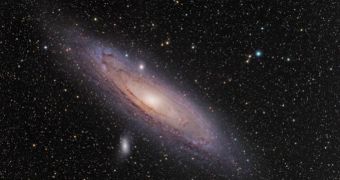While investigating nearby galaxies, including our closest neighbor Andromeda, astronomers were surprised to discover that most of them showed signs of having gobbled down smaller galaxies. The structures, too small to make it on their own around the giants they orbited, were cannibalized and became a part of the massive galaxies we see today. Astrophysicists say that the process in ongoing, and that massive galaxies across the Universe must be engaging in similar activities, Space reports.
The only clear indicator that experts have of the fact that the dwarf galaxies existed in the first place comes under the form of tidal streams, which are often likened to cosmic “skid marks.” They are trails of stars that have been left behind by the small galaxy, right before it fell into its massive companion and united its stars with those of the massive structure it was orbiting. In addition to being swallowed almost entirely, the little galaxies were also ripped apart by the impressive gravitational forces that structures such as the Milky Way produced in their vicinity.
By studying the tidal stream, astronomers can now use modern techniques to determine the size and age of the former galaxy, as well as details about its origins and directions. “You can see these very complex systems of shells and plumes of tidal debris that mark the past accretion history of the galaxy,” Case Western Reserve University astronomer Chris Mihos explains. The expert and his team were recently able to identify a large number of tidal streams around several galaxies in the Virgo Cluster.
The formation is relatively close by, just some 50 million light-years away. The Milky Way itself is heading for the center of the supercluster, and it is scheduled to collide with Andromeda along the way, in about 4.5 billion years. “The tidal stream gives you a window in time during which the events happened: the last couple billion years. If it was earlier, it's unlikely we'd still see the stars,” University of California in Santa Cruz (UCSC) expert Puragra Guhathakurta adds. He has been the leader of a team that analyzed the Andromeda Galaxy in detail. Our neighbor is just 2.5 million light-years away.
“It looks like our sister galaxy has led a more exciting life. In contrast the Milky Way has had a relatively quiet, quiescent last couple billion years,” the expert says. It would appear that Andromeda collided at least two times in the past few billion years, whereas our galaxy has been minding its own business. Both Mihos and Guhathakurta presented their findings last week in Washington DC, at the 215th meeting of the American Astronomical Society (AAS).

 14 DAY TRIAL //
14 DAY TRIAL //